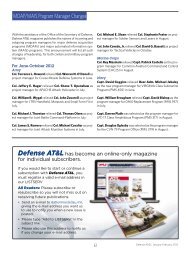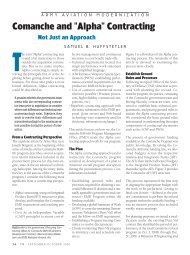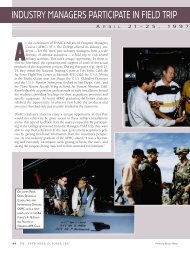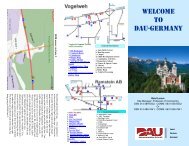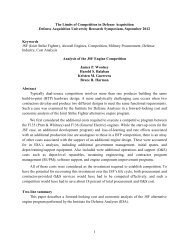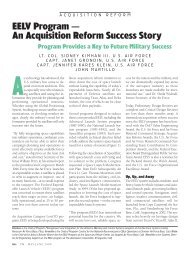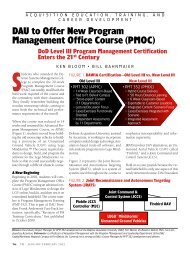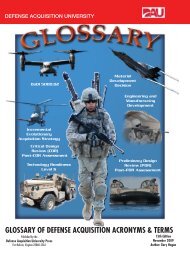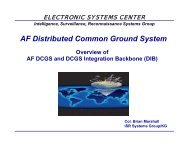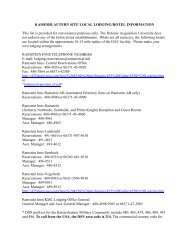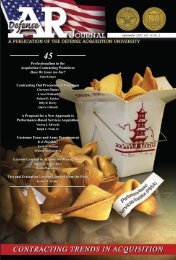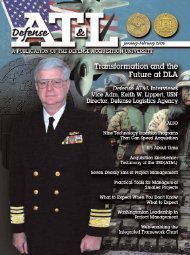Defense ARJ - Defense Acquisition University
Defense ARJ - Defense Acquisition University
Defense ARJ - Defense Acquisition University
Create successful ePaper yourself
Turn your PDF publications into a flip-book with our unique Google optimized e-Paper software.
<strong>Defense</strong> <strong>Acquisition</strong> Review Journal<br />
vision provides a highly optimistic example: “With advanced integrated aerospace<br />
capabilities, networked into a system of systems, we’ll provide the ability to find, fix,<br />
assess, track, target, and engage anything of military significance anywhere” (USAF,<br />
2002, p. 6).<br />
Beyond providing state-of-the-art military capabilities, planners also envision<br />
future meta-systems as completely and flawlessly interoperable. One example is<br />
found in the USAF Transformation Flight Plan (2004, p. 69), which promises “a joint<br />
fire control system of systems that enables the Joint Force Commander to seamlessly<br />
across the sensor-to-shooter assets of all the Services, put a cursor over a target in a<br />
timely manner.”<br />
Conceptually, the acquisition community has also embraced SoS development as<br />
essential for meeting future military needs. Commitment to this principle is reflected<br />
in guidance that links success in defense transformation to “network-centric operations<br />
and on individually complex systems linked together in complex systems-ofsystems”<br />
(DAG, 2006, pp. 170-171). Yet initial systems of systems development<br />
efforts suggest the need for new methodologies (Zenishek & Usechak, 2005; Brown<br />
& Flowe, 2005; Luman & Scotti, 1996). The difficulties experienced to date highlight<br />
the need to reconcile substantially differing opinions regarding the distinctions<br />
between an SoS and a highly complex system.<br />
180<br />
The difficulties experienced to date highlight the need to<br />
reconcile substantially differing opinions.<br />
conflictinG aPProacHes to sos DeVeloPMent<br />
Capabilities projected for the technologically superior force of the future require<br />
interoperability that eclipses the state-of-the-art. Descriptions of future meta-systems<br />
imply astonishing utility and flexibility with promises of “multiple autonomous embedded<br />
complex systems that can be diverse in technology, context, operation, geography,<br />
and conceptual frame” (Keating et al., 2003, p. 41). Most important, transformation<br />
proponents envision these interlinked meta-systems providing capabilities far exceeding<br />
those of their individual components. This important aspect of an SoS—exponentially<br />
complementary capabilities—is the basis of proposals to develop affordable yet<br />
tremendously capable military forces centered on adaptive systems of systems.<br />
Many voices in the defense acquisition community assert that the discipline of<br />
Systems Engineering is adequate for SoS development. However, findings of re-



